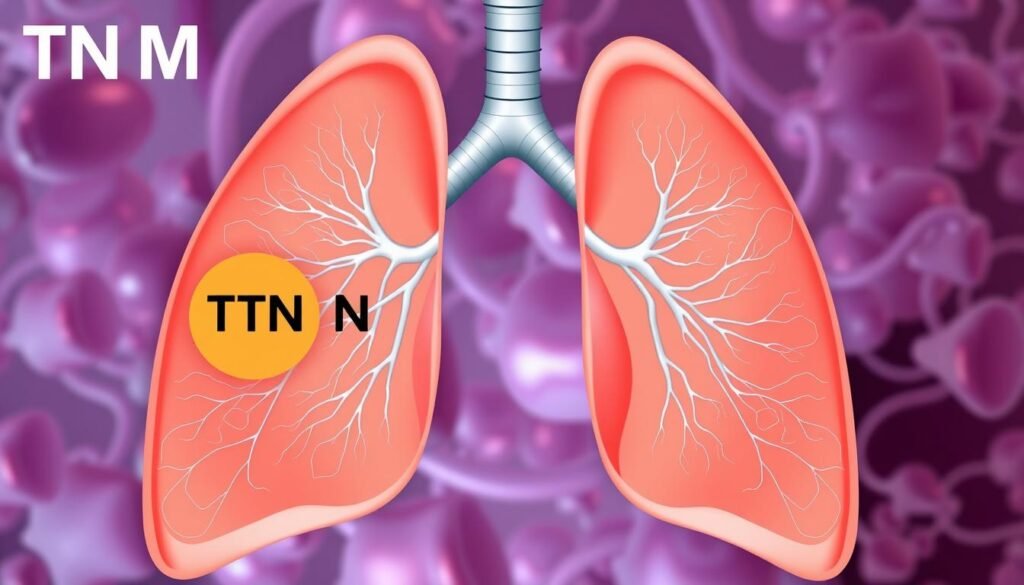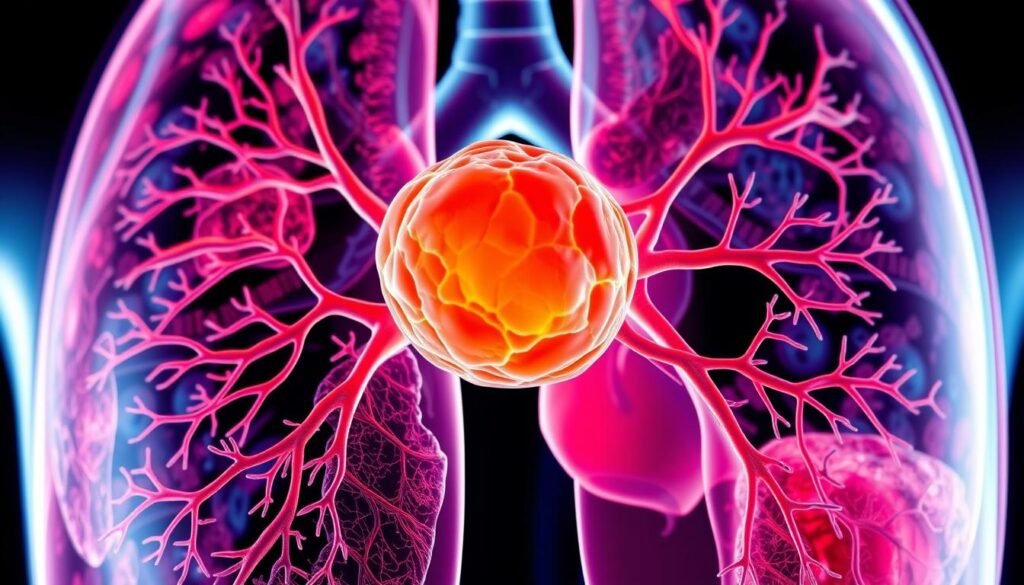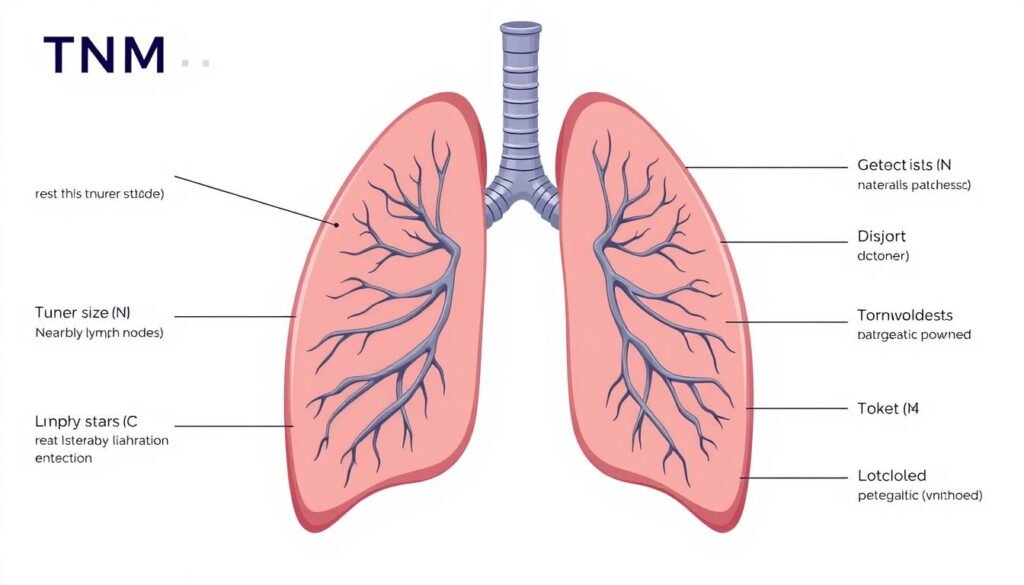Lung cancer is the top cause of cancer deaths for men and women in the U.S. Knowing the TNM staging lung cancer system is key in this battle. It helps categorize patients by how far the cancer has spread. This information is critical for deciding on treatments and predicting outcomes.
The TNM classification looks at Tumors (T), Nodes (N), and Metastasis (M). These factors are crucial for figuring out how severe the lung cancer is. The eighth edition of the TNM system brought important changes. These updates improve how we stage and treat lung cancers. Understanding these changes is vital for managing lung cancer well.
Understanding TNM staging helps patients and doctors get a clear picture of the cancer. In this guide, you will learn about the key parts of cancer staging. This knowledge is essential for handling lung cancer effectively.
Key Takeaways
- Lung cancer remains the leading cause of cancer-related deaths in the U.S.
- TNM staging is critical for determining treatment and prognosis.
- The eighth edition of the TNM classification includes significant updates.
- Accurate staging is vital for effective management of lung cancer.
- Each component of the TNM system provides important insights into the disease.
- Understanding the differences in staging can greatly affect treatment outcomes.
Understanding Cancer Staging
Cancer staging is key in choosing the best plan for lung cancer diagnosis and lung cancer treatment. It tells us the tumor’s size and how far it has spread in the body. This helps doctors decide on the best treatment. They can tailor treatment to fit each patient’s specific situation. This improves the chances of a good outcome.
The Importance of Staging in Cancer Treatment
Staging helps doctors understand how much the cancer has spread. Knowing this helps pick the right treatments and can lead to better results. The TNM classification system explains tumor growth and spread. It describes the tumor’s size, if cancer is in the lymph nodes, and if it has spread elsewhere. Using cancer biomarkers makes staging even more precise. This means treatments can be more personalized.
How Staging Affects Prognosis
The stage of cancer tells a lot about survival chances. It shows how advanced the cancer is. This influences the choice of treatment and the expected results. Early stages like Stage I mean the cancer hasn’t spread much. This usually means a better chance of recovery. Advanced stages like Stage IV mean the cancer has spread far. Treatment plans change as the patient’s condition changes. For more information, visit detailed guides on lung cancer management.
What is the TNM Staging System?
The TNM staging system is key in oncology. It gives a uniform way to check how far lung cancer has spread. This system looks at Tumor (T), Node (N), and Metastasis (M). These parts help doctors decide on treatments and understand a patient’s outlook.
Components of the TNM System: Tumor, Node, Metastasis
Lung cancer is categorized by the TNM system based on:
- Tumor (T): This tells us about the tumor’s size and spread. T1 means it’s small, and T4 means it has grown or spread to nearby places.
- Node (N): This shows if cancer has reached the lymph nodes. N0 means no lymph nodes are involved. N3 means many are affected.
- Metastasis (M): This part is about cancer spreading to distant organs. M0 means it hasn’t spread far, and M1 means it has.
The TNM system helps doctors make the best treatment plans. For more info, check out the TNM staging system for lung cancer.
History and Evolution of the TNM System
The TNM system has grown over seventy years. The Union for International Cancer Control (UICC) started it. Now, it’s used worldwide for staging cancer and helps with global cancer studies.
The latest version is the 8th Edition from 2016 by the AJCC. It improved how lung cancer is categorized. This makes planning treatment better and helps to predict how well treatments will work.
As we learn more about cancer, the TNM system changes. This ensures it stays useful for fighting cancer and improving patient care.
TNM Staging Lung Cancer
Grasping how tnm staging lung cancer works is vital for handling the disease well. It looks at three key areas: the size of the main tumor (T), if the cancer reached nearby lymph nodes (N), and whether it has spread far (M). Since January 1st, 2017, the latest version, the eighth edition, is used for checking non-small cell lung cancer. This detailed system helps doctors figure out the cancer stage and choose the best treatment.
Overview of the TNM Classification for Lung Cancer
The TNM system puts lung cancer into different stages. Early stage, Stage IA (cT1N0), has a survival chance of 77-92% after five years. But, Stage IVB (M1c disease) survival chance drops to 0%. Places like the adrenal glands, brain, liver, and bones are key when cancer spreads. Knowing where cancer has spread helps doctors predict the patient’s outlook and decide on treatments. Tools like PET-CT scans are great for staging lung cancer because they’re more accurate than regular CT scans at checking lymph nodes. For more on the TNM system, check this overview.
Significance of Accurate Staging in Lung Cancer Management
Right staging in lung cancer matters a lot for patient care and decisions. The type of lymph nodes involved affects whether surgery is a choice. N1 nodes mean cancer is in lung nodes on the same side, while N2 and N3 suggest a wider spread. This could change the treatment plan. Only about 25% of patients are fit for surgery when diagnosed, making correct staging crucial. Fast and right staging helps predict how well a patient might recover and personalizes treatment, boosting the chances of survival. Doctors need a clear understanding of the TNM system to tackle lung cancer well. 
Defining Tumor (T) in Lung Cancer Staging
The T classification is key in the TNM system for lung cancer. It shows how big the tumor is and where it has spread. Knowing about T categories is crucial for picking the right treatment and predicting outcomes. The 8th edition of the TNM staging was released in January 2017. It was improved using data from over 33,000 patients and focuses on non-small cell lung tumors without spread.
T Categories Explained: T1 to T4
The T categories are described as follows:
| T Category | Description |
|---|---|
| Tis | Carcinoma in situ (abnormal cell growth without a tumor) |
| T1 | Tumor size ≤ 3 cm |
| T2 | Tumor size > 3 cm but ≤ 5 cm |
| T3 | Tumor size > 5 cm but ≤ 7 cm, or tumors invading nearby structures |
| T4 | Tumor size > 7 cm, or any size with significant invasion into adjacent structures |
There’s a new category, T1mi, for minimally invasive adenocarcinomas. The cutoffs for T1 and T2 are set at 3 cm and 5 cm. Also, how much the tumor invades nearby areas like the main bronchus or diaphragm is important for staging.
Factors Influencing the T Classification
Several important factors affect the TNM classification:
- Tumor size is crucial as it’s linked to survival chances and treatment choices.
- Where the tumor is located affects its classification, especially if it’s close to other organs.
- How invasive the tumor is decides if it’s categorized as T3 or T4, depending on how deep it goes into nearby tissues.
Accurate staging in the TNM system is vital for planning treatment and managing patients.

Understanding Node (N) Classification
The N classification in the TNM staging for lung cancer is crucial. It helps determine how much cancer has spread to lymph nodes nearby. Knowing this is vital for choosing treatments and predicting outcomes. Doctors use CT and FDG PET scans to see if cancer has moved through lymph systems.
Regional Lymph Nodes and Their Importance
Lymph nodes nearby are key in spotting how far the disease has advanced. The N classification explains if these lymph nodes have cancer. It ranges from N0, meaning no lymph nodes are involved, to N3, which means cancer has reached the other side or above the collar bone. Knowing about the nodes influences the way lung cancer treatment is planned. If cancer is found in the nodes, treatments might include drugs all over the body along with surgery or radiation.
Different N Categories: N0 to N3
The lung cancer staging includes N categories from N0 to N3:
| N Category | Description |
|---|---|
| N0 | No regional lymph node involvement |
| N1 | Involvement of ipsilateral hilum nodes |
| N2 | Involvement of ipsilateral mediastinal or subcarinal nodes |
| N3 | Involvement of contralateral mediastinal/hilar nodes or supraclavicular nodes |
Finding the right category through images and biopsy results is key for effective staging. Knowing the category helps pick the best lung cancer treatment and gives clues about survival rates. Understanding N classification makes treatment choices better and helps predict how well patients may do.

Metastasis (M) and Its Implications
In lung cancer care, knowing if the cancer has spread is crucial. This knowledge shapes how doctors plan treatment. The TNM system helps with this. M0 means the cancer hasn’t spread. M1 means it has spread far. This changes how doctors treat the cancer.
How Distant Metastasis Affects Treatment and Prognosis
When lung cancer spreads far, it’s harder to treat. Doctors may use many treatments, like chemotherapy. This is because the cancer is tougher to beat. Sadly, this also means survival rates may be lower. So, knowing if the cancer is M0 or M1 is key. It helps doctors decide on the best treatment.
M Categories: M0 and M1 Explained
The TNM system’s M part tells doctors about cancer’s spread.
| M Category | Description | Implications for Treatment |
|---|---|---|
| M0 | No distant metastasis | Localized treatment options, such as surgery, may be considered. |
| M1 | Distant metastasis present | Systemic therapy is often necessary; treatment may include chemotherapy or immunotherapy. |
Knowing the difference between M0 and M1 is vital. It guides doctors in choosing treatment. With today’s personalized medicine, understanding cancer’s stage is more important than ever. This helps improve lung cancer care.
Differences Between Small Cell and Non-Small Cell Lung Cancer Staging
Understanding how non-small cell lung cancer (NSCLC) and small cell lung cancer (SCLC) are staged is key. It helps to decide on the best treatment and predict outcomes. NSCLC uses the TNM system, covering tumor size, lymph nodes, and metastasis. In contrast, SCLC is split into just limited or extensive stages. These staging differences greatly affect how patients are treated.
Staging for Non-Small Cell Lung Cancer (NSCLC)
NSCLC’s stage is determined using the TNM classification. It looks at tumor size, its location, lymph node involvement, and if it has spread. There are several stages for NSCLC:
- Occult stage: Cancer can’t be seen with imaging or bronchoscopy.
- Stage 0: Abnormal cells exist but haven’t spread to nearby tissues.
- Stage I: Split into Stage IA and IB, depending on tumor size and lymph nodes.
- Stage II: Has types 2A and 2B, based on tumor size and node involvement.
- Stage III: Cancer has likely reached chest lymph nodes.
- Stage IV: Advanced stage, with 4A and 4B showing tumor size and organ spread.
Staging NSCLC involves measuring the tumor in centimeters and using scans and biopsies. The stage affects survival chances. For instance, early-stage NSCLC can have a five-year survival of about 62.8%.
Staging for Small Cell Lung Cancer (SCLC)
SCLC is staged as limited or extensive. Limited means cancer is in one lung and perhaps nearby lymph nodes. Extensive shows the cancer has spread more, maybe to both lungs, the chest wall, or distant organs. This classification guides the treatment plan.
SCLC staging is simpler than NSCLC’s, not detailing tumor size or lymph node status. This approach makes deciding on treatment strategies more straightforward. Knowing if SCLC can be removed or not is crucial for planning patient care.
| Characteristics | Non-Small Cell Lung Cancer (NSCLC) | Small Cell Lung Cancer (SCLC) |
|---|---|---|
| Staging System | TNM classification | Limited vs. Extensive |
| Stages | Occult, 0, I, II, III, IV | Limited or Extensive |
| Treatment Options | Varies by stage, often includes surgery | Based on stage |
| Survival Rates | Different for each stage (about 62.8% for localized stages) | Around 25.4% |
Impact of TNM Staging on Lung Cancer Treatment Options
Knowing how TNM staging works can majorly shape lung cancer care. The TNM staging lung cancer system helps doctors see how far the cancer has spread. This affects what treatment they choose. Early-stage lung cancer might need just surgery, while more advanced stages could require chemotherapy, radiation, or targeted therapies. It’s clear that knowing the exact stage helps pick the best lung cancer treatment for each patient.
Common Treatment Approaches Based on Staging
Oncology care varies a lot with the TNM score. If non-small cell lung cancer (NSCLC) is caught early, surgery could lead to a 50% chance of living 5 more years. But with small cell lung cancer (SCLC), found late, survival drops to 2 to 4 months without treatment, needing aggressive care. Targeted therapies and immunotherapies have become key, based on the tumor’s specifics outlined by the TNM system.
Multidisciplinary Approach in Treatment Planning
Lung cancer’s complexity calls for teamwork in crafting treatment plans. Oncologists, surgeons, radiologists, and palliative care specialists come together to form a full-fledged care plan. By using the TNM system, they sync their efforts, covering every angle of the patient’s health. This team approach boosts the chances of better results and supports patients through their lung cancer journey. To dive deeper into TNM staging and its evolution in lung cancer care, check out this source.